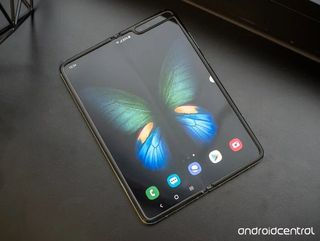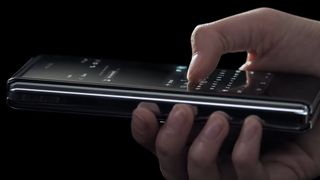My thoughts on the Samsung Galaxy Fold after one week
First impressions of the Galaxy Fold from someone who will be buying a Surface Duo later this year.

I've been fascinated with the Samsung Galaxy Fold ever since it was announced in April last year. Even after "fold gate," which saw the device catastrophically fail in various ways before it even launched, I still wanted one. So when the product finally launched in September 2019 after being "fixed" by Samsung, I came very close to buying one, but ultimately backed down due to its incredibly high price tag and the fact that the Surface Duo would be coming in a year.
But over the holidays, something changed in my head. I started looking at reviews of the Galaxy Fold once again, and even though I know the Surface Duo is coming soon, I still found myself hovering over that buy button on Samsung's website. It was still too expensive, but after selling a bunch of older tech no longer used, that £1,900 price tag became considerably less daunting.
Also, Samsung has a pretty good trade-in program for existing Samsung phone users, which is what ultimately pushed me over the edge. I traded in my Galaxy Note 10+, which slashed a further £550 off that £1,900 price tag. At this point, I'm paying less than I would pay for a new OnePlus phone, so I decided "what the heck" and bought one. I've been using it for over a week now and wanted to share my thoughts.

An entirely new kind of smartphone.
The Samsung Galaxy Fold is something special. It's the first foldable phone to launch in the United States and makes every other handset look like a piece of ancient history. There are still some quirks with folding phones as a whole, but if you want to buy one, this is probably the one to get.
Exquisite hardware

Kicking things off with the hardware, the Galaxy Fold is a beautiful piece of kit. It feels fantastic to hold, and the hinge/magnet combination for opening and closing the device reminds me of the kickstand on the Surface Pro. Closing the device is so incredibly satisfying that I find myself doing it just for fun, even if I'm not done using the thing.
There are your usual volume and power buttons along the right side of the device — all are satisfying to press. There's also a dedicated fingerprint reader, which I find to be just a little bit too low for it to read my fingerprint accurately. When I'm holding the phone naturally, I have to adjust to place my thumb or finger on it successfully. It should be higher up on the phone, perhaps built into the power button.
I will say that I prefer this to what the Galaxy Fold was originally going to ship with. This is something I didn't see reviewers make note of when the Galaxy Fold re-launched in September. Initially, the fingerprint reader was going to double as a dedicated Bixby button, which would have sucked big time. Samsung changed this with the shipped product, but I haven't seen anyone else mention that. It's no longer a button, just a capacitive area for fingerprints.
There are also six cameras, all of which are pretty good. I won't be diving into the cameras here, so make sure you check out Android Central's review for a look at those.
Get the Windows Central Newsletter
All the latest news, reviews, and guides for Windows and Xbox diehards.
About those displays

The 7.3-inch foldable screen on the inside is something many people worry about, but after a week, I'm already over it. Although plastic, it's not "fragile" like most have described it to be. Sure, you need to treat it with a little more care compared to a glass phone, and you shouldn't use any sharp or pointy objects directly on the display, but it's not going to break from regular use.
The inside display isn't soft like I was expecting it to be, and more or less looks and feels like a normal screen. There is a crease down the middle, which is a side-effect of it being able to fold, but when viewed straight on (the angle in which you use the device almost always), it's rarely visible. You can feel it when you run your finger across the screen, but I wouldn't say it's much of an issue.
Having this size display with you on the go is incredible.
Having this size display with you on the go is incredible. When you reduce the UI scaling to the smallest setting, which everyone should, many apps will run in their "tablet" UI, including several Microsoft apps that gives you way more content on the screen at once. It's like having a tiny PC in your pocket when running apps like Outlook or Edge. I'll get to that more in the software section.
Samsung has also put a cover display on the outside of the device for doing quick tasks and checking notifications. This is covered in glass and therefore, can be treated like a typical smartphone display, even though it's pretty small. In fact, I'd say this screen is too small for a display that can do "everything" a normal smartphone can do.
If this display was limited to checking the time, notifications, and quick settings, then it'd be fine. But Samsung treats this display a fully-fledged area for Android. That means you can run apps on it, and it even has its very own home screen. In my opinion, it's just too small for those kinds of tasks. This cover display needs to be way bigger than it is for it not to be a frustrating experience outside of checking notifications.
I originally thought that external display would be unnecessary, but I've found it to be a vital part of the "foldable" experience. Without the cover display, checking notifications and answering calls would be annoying, because you wouldn't be able to see what those notifications are or who is calling. With a foldable, doing stuff on the inside screen requires an extra step: opening the device.
The OS experience

On the software side of things, the Galaxy Fold is fine. I'm still not a massive fan of OneUI 1, and while OneUI 2.0 does improve things in the animation and fluidity department, that update isn't yet available for the Galaxy Fold. The device launched with OneUI 1.5, which comes with Your Phone integration like on the Galaxy Note 10+ and other Galaxy devices.
Out of the box, the UI scaling is a little on the large side for the bigger foldable screen. By default, apps run with their mobile UIs on the larger display, which is fine for many, but with a display this big, I want my experience to be a little denser. So I dropped the scaling to the smallest setting, which makes many apps run in their tablet-orientated UI instead.
Software on the Samsung Galaxy Fold is a mixed bag.
Many of Microsoft's apps have these dedicated tablet UI's, which are just mobile UI's that are a little more dense and showcase more content at once. For example, with Outlook, you can get both your email list and a preview of the email at the same time, just like on a PC. With Microsoft Edge, you get a UI with a tabbed interface along the top.
You may not prefer this, which I assume is the reason the UI scaling is so high by default. There's also multitasking capabilities that let you run several apps on-screen at once. Three docked, and more in little windows. I don't use this feature much, however, because although the screen is 7.3-inches, it's not big enough to comfortably use more than two apps at a time.
The Galaxy Fold has a feature called app continuity that lets you continue using an app across the small and large display. Most apps are pretty good at adjusting their UI's across both screens, but not all of them. Skype, for example, doesn't support this at all and will need to relaunch if you try to use the app after opening it on another display first. Then there are apps like Edge and Instagram, which do support it, but have minor issues.
With Instagram, comments will sometimes run off the screen on the small display, and Instagram stories do not support the larger screen well at all. Microsoft Edge doesn't switch between the mobile UI and tablet UI when going between screens. I assume this is more of an Android issue as Google Chrome doesn't do this either.
Galaxy Fold vs Surface Duo

The real reason I wanted a Galaxy Fold was so I could compare it to the Surface Duo when that launches this year. While technically different, they both fall under the foldable phones category of devices, one using a foldable screen, the other two displays joined together by a hinge. I'm yet to go hands-on with the Surface Duo, but I'm already starting to see some problems with that design.
First of all, the Duo not having a screen on the outside is going to be a pain point for many. Like I said above, I didn't think an outer screen was necessary until I actually had the Galaxy Fold in my hands. With that said, the Surface Duo can fold all the way around, unlike the Galaxy Fold. So you can use the screens out the "outside" if you want. However, that doesn't help if you've already closed the device and you've got a call coming in.

After using the Galaxy Fold for a week, I do think having two displays is much more useful than one display. No matter how big the one screen is, I'm rarely going to use it to do two things at once, even if I want to. With two displays, you're forced into taking advantage of that second display, which I assume is the basis of Microsoft's claims that having dual-screens is more productive.
Now that I've used a Galaxy Fold with its one display, I can see where Microsoft is coming from with that statement. I like the Galaxy Fold's single display to show more tablet-orientated UI inside one app at a time. But I think I would prefer having two smaller screens that run apps with their mobile UI instead. I feel like I can do more with two displays over the one larger display on the Galaxy Fold.
But, as I said, I've not had the chance to really go hands-on with a Surface Duo just yet. Overall, I like the Galaxy Fold. It's most certainly a first-generation product, but it shows promise for this category. I like the idea of having a device that fits in your pocket that can fold out into something much bigger. Both the Galaxy Fold and Surface Duo achieve this but in very different ways. I'm excited to see where this goes in 2020.

An entirely new kind of smartphone.
The Samsung Galaxy Fold is something special. It's the first foldable phone to launch in the United States and makes every other handset look like a piece of ancient history. There are still some quirks with folding phones as a whole, but if you want to buy one, this is probably the one to get.
